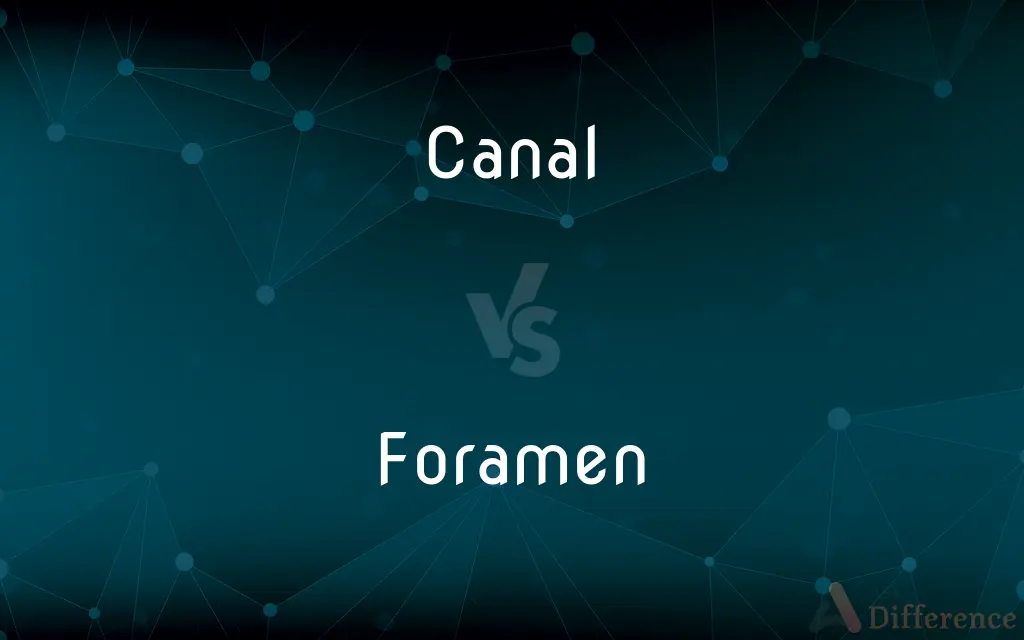Canal vs. Foramen — What's the Difference?
By Tayyaba Rehman & Urooj Arif — Updated on March 22, 2024
Canals are human-made waterways for navigation and irrigation, while foramina are natural openings in bones for nerves.

Difference Between Canal and Foramen
Table of Contents
ADVERTISEMENT
Key Differences
Canals are engineered channels, created for the purpose of water navigation and irrigation, facilitating the transportation of goods and water resources across various regions. On the other hand, foramina are naturally occurring openings or holes found in the bones of living organisms, including humans, through which nerves, vessels, and other structures can pass. While canals are a testament to human ingenuity in modifying landscapes to suit transportation and agricultural needs, foramina play a crucial role in the anatomical and physiological functioning of organisms by allowing the passage of essential structures.
Canals, as human-made waterways, significantly impact economic and social structures by enhancing trade routes and agricultural productivity. Foramina, in contrast, are vital for the biological functions of organisms, including humans, as they allow for the passage of nerves that are essential for nourishment and communication within the body. The existence and maintenance of canals reflect societal and technological advancements, whereas the presence and function of foramina are indicative of evolutionary processes that have optimized the anatomy of living beings for survival and efficiency.
The construction and maintenance of canals require substantial engineering, planning, and resources, illustrating human efforts to overcome geographical barriers and to facilitate economic growth. Foramina, however, are formed through biological processes during the development of the organism, highlighting the natural complexity and efficiency of living systems. Canals are thus a reflection of human ambition to control and utilize natural resources, while foramina represent the intricate design of nature in ensuring the health and functionality of organisms.
In terms of environmental impact, canals can alter local ecosystems, water tables, and landscapes, sometimes leading to ecological challenges. Foramina, being part of natural biological structures, do not have an environmental impact but are essential for the physiological functioning of organisms. The modification of natural landscapes through canal building can lead to both positive and negative environmental effects, whereas foramina are integral to the internal ecosystems of organisms, facilitating essential bodily functions.
Despite their differences, both canals and foramina embody the concept of connectivity, albeit in vastly different contexts. Canals connect disparate geographical locations, facilitating human interaction and the exchange of goods and ideas. Foramina connect different parts of an organism’s body, ensuring the flow of information, nutrients. This underlying theme of connectivity underscores the importance of both canals and foramina in their respective domains of human activity and biological life.
ADVERTISEMENT
Comparison Chart
Definition
Engineered waterway for navigation and irrigation.
Natural opening in bones for nerves and vessels.
Construction
Human-made, requiring significant planning and resources.
Naturally occurring, formed through biological processes.
Impact
Alters landscapes and ecosystems, can have both positive and negative environmental effects.
Essential for physiological functions, does not impact the external environment.
Symbolism
Represents human ingenuity and the desire to overcome geographical barriers.
Reflects the complexity and efficiency of natural biological systems.
Compare with Definitions
Canal
Can significantly impact local economies by boosting trade.
The Suez Canal is vital for international shipping and trade.
Foramen
A natural opening or passage in a bone.
The foramen magnum is where the spinal cord enters the skull.
Canal
Often features locks and dams to control water levels.
The lock system of the Erie Canal regulates water flow and boat passage.
Foramen
Reflects evolutionary adaptations for organism survival.
Skull foramina have evolved to accommodate brain expansion.
Canal
May lead to environmental and ecological changes.
Construction of canals has altered natural habitats and water tables.
Foramen
Essential for bodily functions and communication.
The vertebral foramina house the spinal cord.
Canal
A man-made waterway used for navigation, irrigation, or drainage.
The Panama Canal connects the Atlantic and Pacific Oceans.
Foramen
Varies in size based on its location and function.
The obturator foramen in the pelvic bone is among the largest.
Canal
Represents human efforts to manipulate landscapes for benefit.
The Grand Canal in China is a monumental feat of engineering.
Foramen
In anatomy and osteology, a foramen (; plural foramina, or foramens ) is an open hole that is present in extant or extinct amniotes. Foramina inside the body of animals typically allow muscles, nerves, arteries, veins, or other structures to connect one part of the body with another.
Canal
Canals are waterway channels, or artificial waterways, for water conveyance, or for servicing water transport vehicles. They carry free surface flow under atmospheric pressure, and can be thought of as artificial rivers.
Foramen
An opening or orifice, as in a bone or in the covering of the ovule of a plant.
Canal
An artificial waterway constructed to allow the passage of boats or ships inland or to convey water for irrigation
The Oxford Canal
They travelled on by canal
Foramen
(skeleton) An opening, an orifice, or a short passage, especially in a bone.
The skull contains a number of foramina through which arteries, veins, nerves, and other structures enter and exit.
Canal
A tubular duct in a plant or animal, serving to convey or contain food, liquid, or air
The ear canal
Foramen
A small opening, perforation, or orifice; a fenestra.
Canal
Any of a number of linear markings formerly reported as seen by telescope on the planet Mars.
Foramen
A natural opening or perforation through a bone or a membranous structure
Canal
An artificial waterway or artificially improved river used for travel, shipping, or irrigation.
Canal
(Anatomy) A tube, duct, or passageway.
Canal
(Astronomy) One of the faint, hazy markings resembling straight lines on early telescopic images of the surface of Mars.
Canal
To dig an artificial waterway through
Canal an isthmus.
Canal
To provide with an artificial waterway or waterways.
Canal
An artificial waterway or artificially improved river used for travel, shipping, or irrigation.
Canal
(anatomy) A tubular channel within the body.
Canal
(astronomy) One of the faint, hazy markings resembling straight lines on early telescopic images of the surface of Mars; see Martian canals
Canal
To dig an artificial waterway in or to (a place), especially for drainage
Canal
To travel along a canal by boat
Canal
An artificial channel filled with water and designed for navigation, or for irrigating land, etc.
Canal
A tube or duct; as, the alimentary canal; the semicircular canals of the ear.
Canal
A long and relatively narrow arm of the sea, approximately uniform in width; - used chiefly in proper names; as, Portland Canal; Lynn Canal.
Canal
(astronomy) an indistinct surface feature of Mars once thought to be a system of channels; they are now believed to be an optical illusion
Canal
A bodily passage or tube lined with epithelial cells and conveying a secretion or other substance;
The tear duct was obstructed
The alimentary canal
Poison is released through a channel in the snake's fangs
Canal
Long and narrow strip of water made for boats or for irrigation
Canal
Provide (a city) with a canal
Common Curiosities
Can humans create foramina?
Humans cannot create natural foramina, but they can surgically create openings in bones for medical purposes.
How do canals affect local economies?
Canals can significantly boost local economies by facilitating trade and transportation.
How are foramina formed?
Foramina are formed through natural biological processes during the development of the organism.
How do canals impact the environment?
Canals can alter landscapes, affect water tables, and potentially lead to ecological changes, both positive and negative.
Can the construction of canals lead to negative environmental impacts?
Yes, canal construction can sometimes lead to negative environmental impacts, including habitat destruction and changes to local water systems.
What is a canal?
A canal is an artificial waterway created for navigation, irrigation, or drainage purposes.
What is the largest man-made canal in the world?
The title for the largest man-made canal has historically been contested, with contenders including the Panama Canal and the Suez Canal based on various criteria.
How do canals contribute to global trade?
Canals reduce travel distance and time for shipping routes, significantly contributing to the efficiency of global trade.
Are all foramina the same size?
No, the size of foramina varies depending on their location and the structures they accommodate.
What is the role of foramina in the nervous system?
Foramina allow nerves to pass through bones, facilitating communication within the body and between the body and external environment.
Are there any famous historical canals?
Yes, historical canals like the Grand Canal in China and the Erie Canal in the United States are famous for their engineering marvels and impact on society.
Share Your Discovery

Previous Comparison
Slipper vs. Sandal
Next Comparison
Dialogue vs. DuologueAuthor Spotlight
Written by
Tayyaba RehmanTayyaba Rehman is a distinguished writer, currently serving as a primary contributor to askdifference.com. As a researcher in semantics and etymology, Tayyaba's passion for the complexity of languages and their distinctions has found a perfect home on the platform. Tayyaba delves into the intricacies of language, distinguishing between commonly confused words and phrases, thereby providing clarity for readers worldwide.
Co-written by
Urooj ArifUrooj is a skilled content writer at Ask Difference, known for her exceptional ability to simplify complex topics into engaging and informative content. With a passion for research and a flair for clear, concise writing, she consistently delivers articles that resonate with our diverse audience.














































